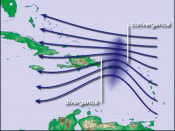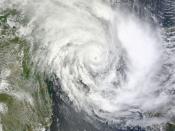Hurricanes
Hurricanes get their start over the warm tropical waters of the North
Atlantic Ocean near the equator. Most hurricanes appear in late summer or
early fall, when sea temperatures are at their highest. The warm waters
heats the air above it, and the updrafts of warm, moist air begin to rise.
Day after day the fluffy cumuli form atop the updrafts. But the cloud
tops rarely rise higher than about 6,000 feet.
At that height in the tropics, there is usually a layer of warm, dry air
that acts like an invisible ceiling or lid.
Once in a while, something happens in the upper air that destroys
this lid. Scientist don not know how this happens. But when it does, it's
the first step in the birth of a hurricane.
With the lid off, the warm, moist air rises higher and higher. Heat
energy, released as the water vapor in the air condenses.
As it condenses
it drives the upper drafts to heights of 50,000 to 60,000 feet. The
cumuli become towering thunderheads.
From outside the storm area, air moves in over the sea surface to
replace the air soaring upwards in the thunderheads. The air begins
swirling around the storm center, for the same reason that the air
swirls around a tornado center.
As this air swirls in over the sea surface, it soaks up more and
more water vapour. At the storm center, this new supply of water vapor
gets pulled into the thunderhead updrafts, releasing still more energy
as the water vapor condenses. This makes the updrafts rise faster,
pulling in even larger amounts of air and water vapor from the storm's
edges. And as the updrafts speed up, air swirls faster and faster around
the storm center. The storm clouds, moving with the swirling...


